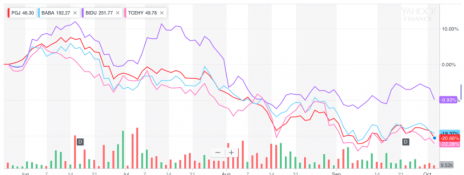After months of bluster and posturing, the trade war between the U.S. and China actually resulted in the imposition of tariffs and counter-tariffs a couple of months ago.
For growth investors interested in the three largest Chinese internet stocks, it’s been a trying time. Baidu (BIDU), Alibaba (BABA) and Tencent Holdings (TCEHY) (i.e. the BAT stocks) have been unable to make any progress for an extended period. BIDU and BABA really lost momentum in late 2017 and TCEHY peaked in January 2018.
But my message for today is that these stocks aren’t as unhealthy as they seem. They’re not buyable yet, but their charts hide a secret that is easy to miss if you just click on each in your charting service.
[text_ad use_post='129628']
The biggest thing to notice is that, if you take a quick look at the Invesco Golden Dragon China ETF (PGJ), an ETF that tracks the performance of Chinese stocks that trade on U.S. exchanges as ADRs, you will see that the BAT stocks are moving as a group, not as individual stocks.
Here’s a chart from Yahoo! Finance that shows PGJ (in red) and the BAT stocks (BABA in light blue, BIDU in purple and TCEHY in pink) from late May.
As mentioned above, what the chart shows (with a little divergence from BIDU’s July lift) is that all of these stocks are moving pretty much in lockstep with one another. The trend has been down since the middle of June. And that’s important because the movement in a stock that’s caused by a general market move says very little about investors’ attitudes toward the individual companies and a lot about general risk aversion and capital flows into and out of Chinese growth stocks.
The three BAT stocks have been hit with trade-war worries and a series of sensational stories about what might happen to the Chinese economy if Chinese exports really suffer a downturn.
But analysts are still forecasting 14% revenue growth for Baidu next year, with Alibaba’s growth estimated at 35% and Tencent Holdings’ at 37%. And that’s on top of revenue growth of 20% (BIDU), 65% (BABA) and 57% (TCEHY) last year.
Those sound like pretty good numbers to me.
If you want to know when it’s time to move back into any of these three giants, all you have to do is watch the Golden Dragon ETF (PGJ). When it gets moving, I can just about guarantee that the BAT stocks are also on the rebound. And when that happens, you can just pick your favorite story and enjoy the ride—a ride that could go on for a while given the depths of this year’s downturn.
The investment advisory that I write, Cabot Global Stocks Explorer, uses the Golden Dragon and other, broader emerging market ETFs to take the temperature of emerging market stocks. I keep close track of the momentum reflected in PGJ, and I move the Cabot Emerging Market Investor’s portfolio into cash when conditions are bearish (as they are now) and back toward fuller investment when the bulls regain control.
Right now, I have the portfolio positioned 70% in cash and I have only one of the BAT stocks (Alibaba) in the portfolio with a Hold rating. But Baidu is on the Watch List and Tencent Holdings is never far from my thoughts.
When PGJ tells me that investors are ready to put money to work in riskier situations, I’ll be ready.
[author_ad]


